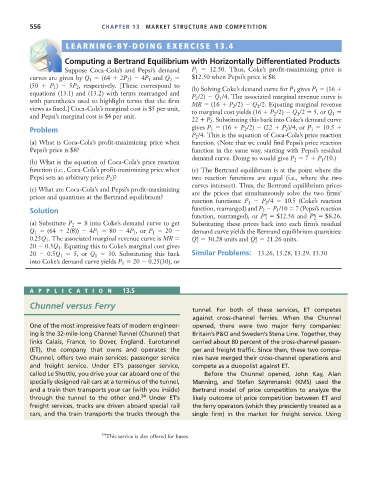Page 582 - Microeconomics, Fourth Edition
P. 582
c13marketstructureandcompetition.qxd 7/30/10 10:44 AM Page 556
556 CHAPTER 13 MARKET STRUCTURE AND COMPETITION
LEARNING-BY-DOING EXERCISE 13.4
S
D
E
Computing a Bertrand Equilibrium with Horizontally Differentiated Products
Suppose Coca-Cola’s and Pepsi’s demand P 1 12.50. Thus, Coke’s profit-maximizing price is
curves are given by Q 1 (64 2P 2 ) 4P 1 and Q 2 $12.50 when Pepsi’s price is $8.
(50 P 1 ) 5P 2 , respectively. [These correspond to (b) Solving Coke’s demand curve for P 1 gives P 1 (16
equations (13.1) and (13.2) with terms rearranged and P 2 /2) Q 1 /4. The associated marginal revenue curve is
with parentheses used to highlight terms that the firm MR (16 P 2 /2) Q 1 /2. Equating marginal revenue
views as fixed.] Coca-Cola’s marginal cost is $5 per unit, to marginal cost yields (16 P 2 /2) Q 1 /2 5, or Q 1
and Pepsi’s marginal cost is $4 per unit.
22 P 2 . Substituting this back into Coke’s demand curve
Problem gives P 1 (16 P 2 /2) (22 P 2 )/4, or P 1 10.5
P 2 /4. This is the equation of Coca-Cola’s price reaction
(a) What is Coca-Cola’s profit-maximizing price when function. (Note that we could find Pepsi’s price reaction
Pepsi’s price is $8? function in the same way, starting with Pepsi’s residual
demand curve. Doing so would give P 2 7 P 1 /10.)
(b) What is the equation of Coca-Cola’s price reaction
function (i.e., Coca-Cola’s profit-maximizing price when (c) The Bertrand equilibrium is at the point where the
Pepsi sets an arbitrary price P 2 )? two reaction functions are equal (i.e., where the two
curves intersect). Thus, the Bertrand equilibrium prices
(c) What are Coca-Cola’s and Pepsi’s profit-maximizing are the prices that simultaneously solve the two firms’
prices and quantities at the Bertrand equilibrium?
reaction functions: P 1 P 2 /4 10.5 (Coke’s reaction
Solution function, rearranged) and P 2 P 1 /10 7 (Pepsi’s reaction
function, rearranged), or P* 1 $12.56 and P* 2 $8.26.
(a) Substitute P 2 8 into Coke’s demand curve to get Substituting these prices back into each firm’s residual
Q 1 (64 2(8)) 4P 1 80 4P 1 , or P 1 20 demand curve yields the Bertrand equilibrium quantities:
0.25Q 1 . The associated marginal revenue curve is MR Q* 1 30.28 units and Q* 2 21.26 units.
20 0.5Q 1 . Equating this to Coke’s marginal cost gives
20 0.5Q 1 5, or Q 1 30. Substituting this back Similar Problems: 13.26, 13.28, 13.29, 13.30
into Coke’s demand curve yields P 1 20 0.25(30), or
APPLICA TION 13.5
Chunnel versus Ferry
tunnel. For both of these services, ET competes
against cross-channel ferries. When the Chunnel
One of the most impressive feats of modern engineer- opened, there were two major ferry companies:
ing is the 32-mile-long Channel Tunnel (Chunnel) that Britain’s P&O and Sweden’s Stena Line. Together, they
links Calais, France, to Dover, England. Eurotunnel carried about 80 percent of the cross-channel passen-
(ET), the company that owns and operates the ger and freight traffic. Since then, these two compa-
Chunnel, offers two main services: passenger service nies have merged their cross-channel operations and
and freight service. Under ET’s passenger service, compete as a duopolist against ET.
called Le Shuttle, you drive your car aboard one of the Before the Chunnel opened, John Kay, Alan
specially designed rail cars at a terminus of the tunnel, Manning, and Stefan Szymmanski (KMS) used the
and a train then transports your car (with you inside) Bertrand model of price competition to analyze the
through the tunnel to the other end. 34 Under ET’s likely outcome of price competition between ET and
freight services, trucks are driven aboard special rail the ferry operators (which they presciently treated as a
cars, and the train transports the trucks through the single firm) in the market for freight service. Using
34 This service is also offered for buses.

